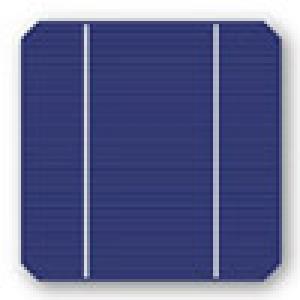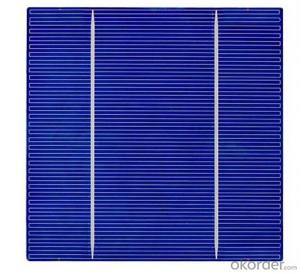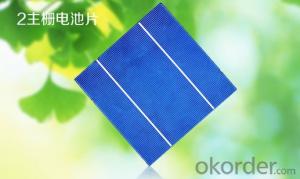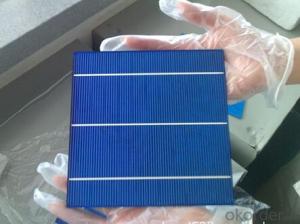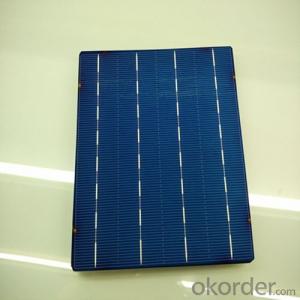Polysilicon Solar Cells PV Mono 2BB Cells
- Loading Port:
- China Main Port
- Payment Terms:
- TT OR LC
- Min Order Qty:
- -
- Supply Capability:
- -
OKorder Service Pledge
OKorder Financial Service
You Might Also Like
We supply regular mono 125x125mm and poly 156x156mm solar cells.
Cells made in China mainland and Taiwan are both available.
Cell production capacity yearly reach 1GW.
Our cells pattern include continuous and uncontinuous busbar to meet different cells line.
our cells special features:
1. High conversion efficiencies resulting in superior power output performance
2.Outstanding power output even in low light or high temperature conditions
3.Optimized design for ease of soldering and lamination
4.Long-term stability,reliability and performance
5.For 156P poly cells with high efficiency in photovoltaic conversion 16.3%-17.5%.
6.Low inverse current, high shunt resistance and high dependability.

- Q: Does the solar cell generate electricity in the absence of the sun, only in the case of strong lights or lasers? If you can achieve how much, and the same day?
- Sunlight is a composite light, in which only the frequency is greater than the solar cell threshold photons can effectively stimulate the solar cell power generation.
- Q: How do solar cells handle dust storms or sandstorms?
- Solar cells are designed to withstand dust storms or sandstorms by incorporating protective measures. The surface of solar panels is typically made of tempered glass or other durable materials that can resist scratches or damage caused by blowing dust or sand. Additionally, the panels are often tilted or installed at an angle, allowing the wind to blow away any accumulated dust. Regular cleaning and maintenance are also carried out to ensure optimal performance in dusty conditions.
- Q: What is the impact of tree shading on solar cell efficiency?
- Tree shading can have a significant impact on solar cell efficiency. When trees cast shadows on solar panels, they reduce the amount of sunlight reaching the cells, resulting in decreased electricity generation. The shading not only reduces the overall energy output but also causes uneven distribution of light, leading to hotspots on the panels, which can further decrease their efficiency and lifespan. Therefore, it is important to consider tree placement and regularly trim branches to maximize solar cell efficiency.
- Q: Can solar cells be damaged by hail or other weather conditions?
- Yes, solar cells can be damaged by hail or other severe weather conditions. Hailstones or strong winds can cause physical damage to the surface of solar panels, leading to cracks or breakages. Additionally, extreme heat or cold can affect the efficiency and lifespan of solar cells. Therefore, it is important to consider the weather conditions and install appropriate protection measures to safeguard solar panels.
- Q: Can solar cells be used in medical devices?
- Yes, solar cells can be used in medical devices. They can be integrated into various medical devices such as implantable devices (pacemakers), wearable devices (fitness trackers), and portable devices (blood glucose monitors) to provide a sustainable and reliable source of power.
- Q: My solar cells are broken, can I just buy one and replace it?
- No, you just can not do properly
- Q: Can solar cells be used in water purification systems?
- Yes, solar cells can be used in water purification systems. Solar-powered water purification systems utilize solar energy to power the required processes, such as filtration, disinfection, and desalination. Solar cells can generate electricity from sunlight, which can be used to power pumps, UV lamps, or other components of the water purification system. This sustainable and environmentally friendly approach is particularly useful in areas with limited access to electricity or in off-grid locations.
- Q: What is the impact of leaf litter on solar cell performance?
- Leaf litter can have a negative impact on solar cell performance as it can block sunlight, reducing the amount of light reaching the cells and thus decreasing their efficiency. Additionally, leaf litter can also cause shading, leading to hotspots on the solar panels, which can further degrade their performance over time. Regular cleaning and maintenance of solar panels are necessary to mitigate the effects of leaf litter and optimize solar cell performance.
- Q: What materials are used in solar cells?
- The most common materials used in solar cells are silicon, which is the dominant material in the market, as well as other materials such as cadmium telluride, copper indium gallium selenide, and organic materials like polymers.
- Q: Can solar cells be used in electric grid stabilization?
- Yes, solar cells can be used in electric grid stabilization. Solar power can contribute to stabilizing the electric grid by providing a consistent and reliable source of renewable energy. The excess energy generated during peak sunlight hours can be stored in batteries or fed back into the grid, helping to balance the supply and demand. Additionally, solar power can reduce the reliance on traditional power plants, thereby reducing the risk of grid instability caused by disruptions in fossil fuel supply or sudden variations in demand.
Send your message to us
Polysilicon Solar Cells PV Mono 2BB Cells
- Loading Port:
- China Main Port
- Payment Terms:
- TT OR LC
- Min Order Qty:
- -
- Supply Capability:
- -
OKorder Service Pledge
OKorder Financial Service
Similar products
Hot products
Hot Searches
Related keywords
